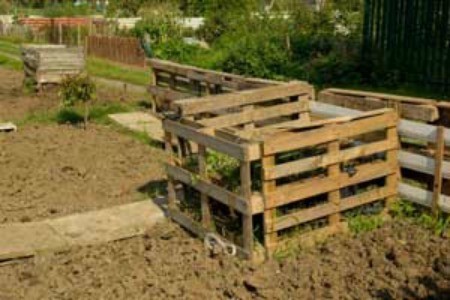How do I make my own compost?Alamuki from Tacoma, WA
Alamuki,
Composting doesn't have to be complicated. There are really no hard and fast rules, but here are some tips for getting started.
Find a convenient place near your garden to start a pile. Avoid low-lying areas. You don't want your pile to stand in water.
A compost pile needs to be large enough to hold in heat and moisture, but small enough to allow air into the center. An ideal size is 3 ft. by 3 ft. by 3 ft. This will give you 1 cubic yard of composting space. Piles smaller than this will work, too, just keep in mind that they have a tendency to dry out faster, which slows down the process.
You can enclose your compost heap using any number of available materials: straw bales, wire or wood fencing, blocks or cement bricks, stones, boards or scrap lumber. If you decide to go with wood, use the cheap stuff because rotting compost will eventually rot the wood and it will just have to be replaced. If you want something a little more fancy, there are a dizzying array of prefabricated bins and barrels available, too. You can also search for do-it-yourself plans online that you can customize to your own tastes.
Now all you need to do is start adding the compost. Each time you add some compost it's a great idea to toss a small bit of dirt on top (this adds the bacteria and microbes that do all the work) and sprinkle the pile with a bit of water. You'll want to keep the pile slightly damp, but not overly wet. Every week or so, use a pitchfork or shovel to turn over the pile.
A good ratio organic matter for optimal composting:
It's best to avoid composting animal products (meat, fish, poultry, fat, bones, eggs, and dairy). They tend to smell. Avoid vegetable oils and do not compost plastics or synthetic fibers.
Ellen

About The Author: Ellen Brown is an environmental writer and photographer and the owner of Sustainable Media, an environmental media company that specializes in helping businesses and organizations promote eco-friendly products and services.
Add your voice! Click below to comment. ThriftyFun is powered by your wisdom!
you can start small using a 5 gallon bucket with a lid. Whenever you have food waste, just throw it in the bucket. If your wanting to make a place outdoor. Remember it needs to breath & be mixed from time to time. Usually making a grid of branches for the bottom and turing the mixture with a rake from time to time.
Broken eggshells are good to add to compost.
If you live in the country, and don't mind what it looks like......
I live in the country, and don't have any neigbors nearby, so I don't care about how this looks LOL.. My kitchen is at the rear of my house, and I have my compost on the ground right down below my kitchen window. My husband took some cheap plastic sheeting, nailed it to my window ledge outside and made kind of a funnel down into my compost opening.
Except for bug season, (when I have a screen in my window) I just have to open my window and drop my vegetable and fruit peelings out my window. Talk about convenience!
I keep my kitchen scraps (coffee grounds, tea bags, vegetable and fruit peelings, eggshells and such) in a plastic lidded Folgers coffee can in the refrigerator. When it is full I take it out to the compost pile which is out in the far corner of my yard, dig into the compost, dump the bucket, bury the food scraps and rinse out the bucket which goes back into the fridge. Composting is a way of giving back to the earth by pulling a double duty on the food you use and with very little effort, you end up with some beautiful compost to use.
Add your voice! Click below to comment. ThriftyFun is powered by your wisdom!